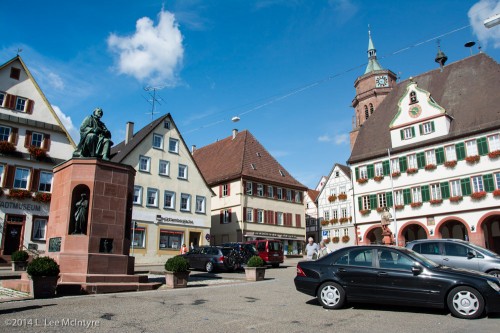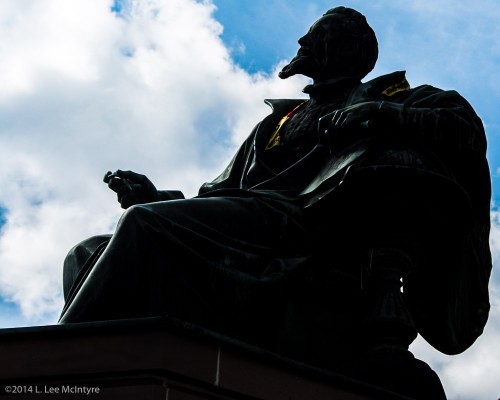The reason we went to the town of Weil der Stadt was not just to check out the planters or eat dessert. Rather, we went to a tiny museum about Johannes Kepler (1571-1630), a key German scientist, astronomer and mathematician who revolutionized the world’s understanding of planetary motion, among many other things.
The town as a whole really celebrates being the birthplace of Kepler; there’s a huge monument to him in the plaza-cum-parking-lot in front of city hall:
My photo of the statue is deliberately done in silhouette; it has had numerous winged visitors leave their mark over the years, which unfortunately distracts a bit from the statue’s overall appearance when the details in the photo aren’t put in shadow, IMHO.
Anyway, the Kepler museum is housed in a building to the left of the city hall building, that is either his actual birthplace, or else a 17th century house built on that same spot.
I read in a town brochure that during the 30 Years War in Germany, most of the buildings in the center of Weil der Stadt were destroyed (the big Catholic church that towers over the city hall and Kepler’s house was rebuilt in the 1600s, for example). Anyway, I didn’t notice at the museum whether it’s supposed to be Kepler’s actual house or not. I didn’t quite process whether or not the museum’s building was one of the few that didn’t have to be rebuilt in the 17th century;
Now the Kepler museum is tiny, but it has an interesting variety of displays and videos to help explain his many scientific theories and discoveries, with a particular focus on how he developed his theory of planetary motion. The original idea accepted by most scientists — and insisted on by the Catholic Church —was the ancient idea that planets and the Sun all orbited around Earth. There were many odd behaviors observed by the motion of the planets, though, that had to be explained away in order to believe in this theory. However, Copernicus in the early 16th century had come up with a theory that perhaps it was really the Sun that the planets were orbiting around, rather than Earth. Kepler came to realize that adopting Copernicus’ notion would allow all the seeming anomalies in the planets’ orbits to be eliminated: the movement of the planets were actually regular and predictable if they were orbiting around the sun. Scandalous in its day, Kepler’s idea has subsequently, of course, been accepted as correct.
Interestingly, the museum didn’t have a lot of information about Kepler’s private life. The displays did note how Kepler had a difficult career, periodically getting kicked out of a town whenever the prevailing ruler changed, and therefore the prevailing religious views changed; Kepler wasn’t popular when he went against church teaching, which he did with almost every church. He lived in a particularly volatile period in Germany, called the 30 Years War, with battles between Catholicism and Lutheranism raging all over the area.
There was only one mention of Kepler’s personal life, and it turns out to be tied to the overall struggles during this period. It seems that Kepler’s mother was put on trial for being a witch in 1617; the museum noted this fact in one sentence, stating that she was released in 1621 thanks to Kepler’s influence, connections and money.
Unfortunately, that was all that was said about the story at the museum. But I figured there had to be a little more to the story. So, I looked it up when we got home, and found this great write-up on a site called ancientworlds.com. As the story there goes, Kepler’s mother was not necessarily a likeable woman and even less so as she got older (even Kepler found her difficult to get along with at times, apparently). During the 30 Years War, people were regularly being accused of practicing black magic and were tried for being witches. That ancientworlds.com site claims that people were regularly burned at the stake for witchcraft; between 1615 and 1629 in Weil der Stadt alone people were burned as witches at the rate of 3 per year.
Now, Kepler’s mother lived in a neighboring town, Leonberg, at this point, not in Weil der Stadt, but Leonberg had a similar track record of witch trials. So, when Kepler’s mother had a dispute over money with someone in town, one thing led to another, and the next thing you knew she was being accused of putting hexes on people, etc, causing illnesses and deaths, and was subsequently arrested and put on trial for witchcraft. Kepler’s younger brother, as well as their sister’s husband, were both prepared to disown and let her burn at the stake as a witch; it’s hinted that their reluctance to defend her could also have had somthing to do with money.
But Kepler came zooming to town to take up his mother’s defense. Now, some of his scientific writings were seen as bordering on the dark arts themselves, though, and he had been constantly at odds with the church(es) about that whole “the earth orbits around the sun rather than the other way round” idea. So, Kepler’s presence alone wasn’t going to be enough to save her.
But he was wealthy enough to be able to pay for a good defense for his mother, and was able to produce evidence in court that cast doubt on all the so-called “proof” of his mother’s evil acts. The local magistrate was pressured by townsfolks to find Kepler’s mother guilty, but found himself troubled by the idea of having to rule against Kepler’s evidence, which might run afoul of Kepler’s powerful patrons. So, the whole matter was referred for judgement to the preeminent seminary in the region, the seminary in Tübingen.
The ruling from there came down: the accusations against Kepler’s mother had merit. Typically in such a case, they would recommend that the accused be tortured to confess before being put to death. However, given that Kepler’s mother was 73, the Tübingen seminary recommended that she merely be taken to the torture chamber and shown all the methods and instruments of torture; the assumption was that the description of all the horrible things that would be done to her in the torture chamber would be enough to get her to confess.
However, she refused to confess, and was taken back to jail while they sorted out what to do next. Kepler continued to apply pressure to get the charges dropped, though, and finally, in 1621, his mother was released and all the charges were dropped. She was then run out of Leonberg by the townspeople, who wanted to lynch her because they remained convinced she was a witch. She died less than a year later, but at least she died a free, exonerated woman, thanks to the efforts of her son.
See, I don’t know why they left all of that out of the museum. Kepler’s scientific impact was extraordinary, to be sure, and the legacy of his discoveries has had a lasting impact on our understanding of the world. But as my father always told me, it’s the stories about the people that are always the most interesting way to gain insight into the people themselves.




Another book or article awaiting your “pen.”